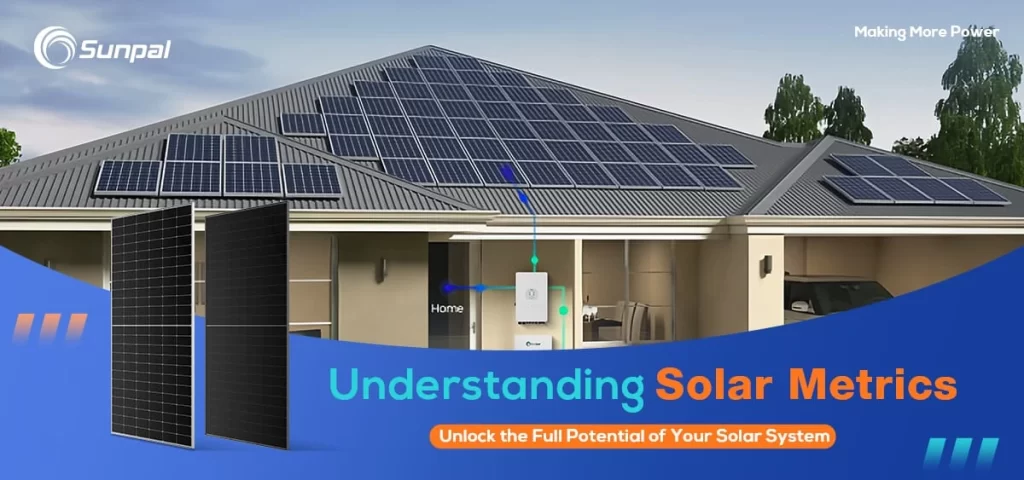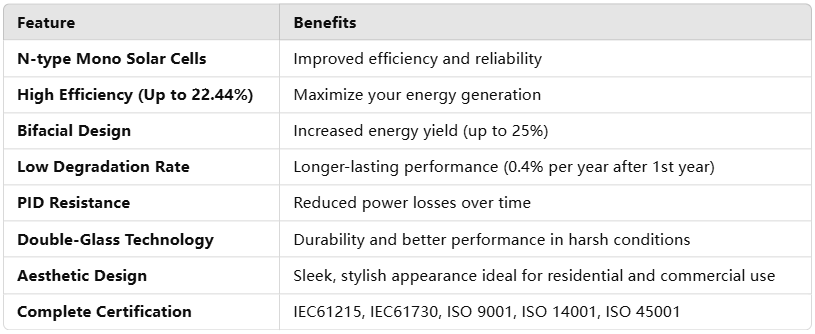
Solar energy is one of the most popular and reliable ways to generate renewable energy, but how do you know if your system is operating at its maximum potential? Are you maximizing your energy production, or is your system not efficient enough?
Understanding Solar Power System Performance Metrics: A Guide to Maximizing Efficiency is designed to help you track, evaluate and improve the performance of your solar power system. Whether you're a homeowner, business owner or part of an industrial facility, understanding these metrics is key to ensuring your investment delivers the energy savings, efficiency and sustainability you expect.
In this article, we’ll dive into the key metrics for monitoring your solar system's performance, explore Sunpal Solar's cutting-edge products like the TOPCon 580W bifacial double-glass solar panels, and show you how to optimize your system for maximum efficiency.
Why Understanding Solar Power System Performance Metrics is Crucial
Performance metrics give you a clear picture of how well your solar system is working. Without them, it’s easy to overlook inefficiencies, underperforming panels, or outdated inverters that might be holding back your energy output.
Key Reasons to Track Solar Performance Metrics:
- Maximize Energy Production: Track how much energy your system produces, and compare it with your expected output. If your panels aren’t meeting expectations, it’s time to investigate.
- Improve System Longevity: Regular monitoring helps you identify issues early, preventing costly repairs and prolonging the life of your system.
- Optimize Financial Savings: Knowing how efficiently your solar system operates helps you save more on your energy bills, maximize your return on investment (ROI), and reduce overall costs.
- Achieve Sustainability Goals: If you’ve set environmental goals, performance metrics are necessary. They help you track whether your system is meeting its energy production targets to reduce your carbon footprint.
Key Solar Power System Performance Metrics You Need to Track
Performance metrics are broken down into a few categories. Each one offers insights into different aspects of your system’s operation. Let's look at the most important ones.
1. Energy Production Metrics
Total Energy Output
Total Energy Output is the most straightforward metric. It measures the energy your system generates over a specified period (daily, monthly, annually). Keeping track of your system’s total energy output ensures that it’s consistently producing energy as expected.
Specific Yield
Specific Yield measures the energy produced per unit of installed capacity (kWh/kWp). It's a great way to assess the overall efficiency of your system. The higher the specific yield, the better the system is at converting sunlight into energy.
Performance Ratio (PR)
The Performance Ratio (PR) is one of the most telling metrics in the solar industry. It compares your system’s actual output to its theoretical maximum. For example, if your system produces 80% of the energy it theoretically could, it’s considered to have an 80% performance ratio. PR takes into account losses due to weather conditions, system design, and other factors.
2. System Efficiency Metrics
Conversion Efficiency
This refers to how efficiently your panels convert sunlight into electricity. Modern panels typically have conversion efficiencies between 15% and 22%, depending on the type of technology used.
Inverter Efficiency
Your inverter plays a crucial role in converting the Direct Current (DC) power generated by your panels into Alternating Current (AC) power, which is used in your home or business. Inverter efficiency is a key performance metric that directly impacts how much of the energy your system produces can be used.
3. Environmental and Operational Metrics
Solar Irradiance
Solar Irradiance refers to the sunlight your panels receive in a given location. It’s measured in kWh/m² and is affected by geographical location, season, and weather conditions. Higher solar irradiance means your system can generate more energy.
Temperature Coefficient
Solar panels work best in cooler conditions. The temperature coefficient tells you how much a panel’s performance decreases with every degree of increase in temperature. Panels with a lower temperature coefficient perform better in hot climates.
Degradation Rate
Over time, solar panels degrade and lose efficiency. The degradation rate tells you how quickly your system will lose efficiency. Modern panels typically experience less than 1% degradation in the first year and 0.4% degradation per year after that, which is critical to understand for long-term planning.
4. Financial Metrics
Levelized Cost of Energy (LCOE)
The Levelized Cost of Energy (LCOE) is the price per unit of energy produced over the lifetime of the solar system. It’s a key metric for comparing the economic viability of different energy solutions, including solar. The lower the LCOE, the better the investment.
Return on Investment (ROI)
Tracking your Return on Investment (ROI) is essential for understanding how quickly your solar system will pay for itself. The ROI is calculated by comparing the system’s initial cost to the savings generated over time. The faster you recoup your initial investment, the better.
Sunpal Solar: Performance-Boosting Technology for Maximum Efficiency
Now that you understand the importance of solar performance metrics, let’s look at how Sunpal Solar products, particularly the TOPCon 580W bifacial double-glass all-black solar panels, can help you achieve superior performance and efficiency.
Why Choose Sunpal Solar’s TOPCon 580W Solar Panels?
Sunpal Solar’s TOPCon 580W bifacial double-glass solar panels are designed for high efficiency, reliability, and long-term performance. Here’s why these panels stand out:
- High Conversion Efficiency (Up to 22.44%): With an advanced N-type TOPCon technology, these panels have one of the highest conversion efficiencies in the industry, ensuring that you get the most energy from every bit of sunlight.
- Bifacial Design for Higher Energy Yield: These panels capture sunlight from both the front and the back, increasing energy production by up to 25% in optimal conditions.
- Low Degradation Rate: The panels have an impressive degradation rate of <1% in the first year and just 0.4% per year from years 2 to 30. This means that your system will generate more energy over time.
- All-Black Aesthetic: These panels are not just high-performing—they look sleek too. The all-black design is aesthetically appealing, making them perfect for residential and commercial applications.
- Durability: Built with double-glass technology, the TOPCon 580W solar panels offer enhanced durability, reducing risks like PID (Potential Induced Degradation) and making them perfect for harsh environments.
- Warranty: With 25-year material and 30-year power warranties, Sunpal Solar guarantees long-lasting performance and peace of mind.
Features and Benefits of Sunpal Solar Panels

Optimizing Solar System Performance: Best Practices
Once your system is installed, the key to maximizing performance is regular monitoring and maintenance. Here’s how to ensure your system operates efficiently:
1. Keep Panels Clean
Dirt and debris on your panels can block sunlight and reduce their efficiency. Clean your panels regularly (but carefully) to ensure maximum energy capture.
2. Adjust Panel Angle
If your panels are adjustable, tweak the angle to optimize sun exposure. This is especially important in seasonal climates where the angle of sunlight changes throughout the year.
3. Regular Maintenance
Routine checks on your solar system, including inspecting connections and ensuring no visible damages, can save you from major issues later on.
4. Upgrade System Components
As solar technology improves, consider upgrading your components. Whether it’s new panels, a better inverter, or energy storage, upgrades can boost your system’s performance.
5. Use Energy Storage
If your system generates excess energy during the day, store it for use during the evening or when cloud cover hits. Integrating batteries with your solar system maximizes energy utilization and reduces grid dependence.
Frequently Asked Questions (FAQs)
1. What is the most important metric for solar system performance?
The Performance Ratio (PR) is one of the most critical metrics. It compares your actual energy production to the theoretical maximum energy production. A PR of 80-90% is ideal.
2. How can I improve the efficiency of my solar system?
To improve efficiency, keep your panels clean, adjust their angle for optimal sun exposure, and consider upgrading older components. Regular monitoring and energy storage integration also help.
3. What is the difference between bifacial and monofacial panels?
Bifacial panels capture sunlight from both sides, increasing energy yield by up to 25%, while monofacial panels only capture sunlight from the front.
4. What’s the expected lifespan of Sunpal Solar panels?
Sunpal Solar’s TOPCon 580W bifacial solar panels are built to last, with a 25-year material warranty and a 30-year power warranty, ensuring consistent performance over time.
5. How does solar panel degradation affect performance?
Solar panels degrade over time, losing efficiency. Sunpal Solar panels have a degradation rate of less than 1% in the first year, ensuring long-lasting performance.
Conclusion: Take Control of Your Solar System’s Performance
By understanding key solar power system performance metrics, you can maximize your system's efficiency, ensure it operates at peak performance, and extend its lifespan. Whether you’re just starting with solar or looking to optimize an existing system, regular monitoring and performance adjustments are crucial.
With Sunpal Solar’s TOPCon 580W bifacial solar panels, you get the latest in technology, energy efficiency, and durability, allowing you to maximize your return on investment while contributing to a greener, more sustainable world.
Ready to maximize your solar system's efficiency? Start by tracking your performance metrics and taking action today with Sunpal Solar.
